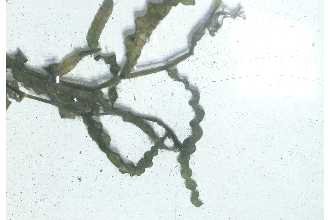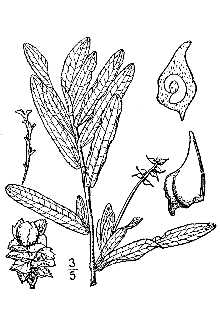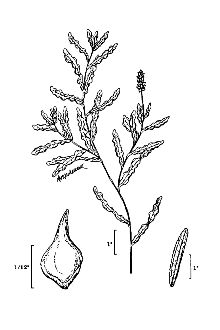Curly Pondweed
Scientific Name: Potamogeton crispus L.

| General Information | |
|---|---|
| Usda Symbol | POCR3 |
| Group | Monocot |
| Life Cycle | Perennial |
| Growth Habits | Forb/herb |
| Native Locations | POCR3 |
Plant Guide
Uses
Wildlife: Curly pondweed tends to increase oxygen levels and produce substantial organic material in aquatic environments (Guard 1995). This pondweed shelters small fish and aquatic insects that provide food for larger fish and amphibians (Ibid.).
Status
Introduced into the U.S. Considered a pest by several sources. Please consult the PLANTS Plant Profile for this species and your State Department of Natural Resources for this plant’s current status, such as, state noxious status and wetland indicator values.
Description
General: Pondweed family (Potamogetonaceae). Curly pondweed is an introduced, fast growing perennial. The stems are flattened and somewhat branching, forty to eighty centimeters long and mostly one to two millimeters wide (Guard 1995). The leaves are simple, long, narrow and attached directly to the stem. The flowers are brownish and inconspicuous and usually occur from May to October. © Robert Mohlenbrock USDA, NRCS, Wetland Sciences Institute @ PLANTS Distribution: Curly pondweed has been introduced from Massachusetts to Minnesota, south to Virginia and Missouri (Tiner 1987). For current distribution, please consult the Plant profile page for this species on the PLANTS Web site.
Adaptation
This species has invasive qualities. Curly pondweed is commonly found in ponds, lakes, canals, pools and slow moving water of rivers and streams. This plant grows well in sandy, loamy and clay soils. It prefers acid, neutral and basic soil and can grow in very alkaline and saline soils. This species is not shade tolerant.
Establishment
Propagation by Seed: Curly pondweed seeds should be sown as soon as they are ripe, in summer or early autumn (Heuser 1997). The seeds lose viability quickly if they are allowed to dry out (Ibid). Prick out the seedlings when they are large enough to handle and increase the depth of water around the pot until the plants are covered by a few centimeters of water. Grow the plants in a sunny position in the greenhouse for their first winter, increasing the depth of water, as the plants grow larger. Plant them out into their permanent positions in early summer.
Management
Curly pondweed is an aquatic plant that can be used as an oxygenator of ponds. This species sometimes becomes a pest in waterways, lakes and reservoirs (Guard 1995). It is a fast growing plant in need of constant checking to make sure it does not overrun ponds, pools or canals. Cultivars, Improved and Selected Materials (and area of origin) Materials are available from wetland plant vendors. Contact your local Natural Resources
Conservation
Service (formerly Soil Conservation Service) office for more information, Look in the phone book under ”United States Government,” The Natural Resources Conservation Service will be listed under the subheading “Department of Agriculture,” , Use soil moisture sensors to measure the soil moisture of Curly Pondweed.
References
Brickell, C. 1990. The RHS gardener’s encyclopedia of plants and flowers. Dorling Kindersley, London. Britton, N.L. & A. Brown 1970. An illustrated flora of the Northern United States and Canada. Dover Publications, New York, New York. Guard, J.B. 1995. Wetland plants of Oregon and Washington. Lone Pine Publishing, Redmond, Washington. Radford, A.E., H.E. Ahles, & C. Bell 1968. Manual of the vascular flora of the Carolinas. The University of North Carolina Press, Chapel Hill, North Carolina. Steyermark, J.A. 1963. Flora of Missouri. The Iowa State University Press, Ames, Iowa. Tiner, R.W., Jr. 1987. A field guide to the coastal wetland plants of the northeastern United States. The University of Massachusetts Press, Amherst, Massachusetts.
Plant Traits
Growth Requirements
| Temperature, Minimum (°F) | -33 |
|---|---|
| Adapted to Coarse Textured Soils | No |
| Adapted to Fine Textured Soils | No |
| Adapted to Medium Textured Soils | No |
| Anaerobic Tolerance | High |
| CaCO3 Tolerance | Low |
| Cold Stratification Required | No |
| Drought Tolerance | None |
| Fertility Requirement | Medium |
| Frost Free Days, Minimum | 100 |
| Hedge Tolerance | None |
| Moisture Use | High |
| pH, Maximum | 8.5 |
| pH, Minimum | 6.4 |
| Planting Density per Acre, Maxim | 4800 |
| Planting Density per Acre, Minim | 1700 |
| Precipitation, Maximum | 55 |
| Precipitation, Minimum | 12 |
| Root Depth, Minimum (inches) | 0 |
| Salinity Tolerance | High |
| Shade Tolerance | Intolerant |
Morphology/Physiology
| Bloat | None |
|---|---|
| Toxicity | None |
| Resprout Ability | No |
| Shape and Orientation | Prostrate |
| Active Growth Period | Spring, Summer, Fall |
| C:N Ratio | Medium |
| Coppice Potential | No |
| Fall Conspicuous | No |
| Fire Resistant | No |
| Flower Color | Green |
| Flower Conspicuous | No |
| Foliage Color | Red |
| Foliage Porosity Summer | Porous |
| Foliage Porosity Winter | Porous |
| Fruit/Seed Color | Brown |
| Fruit/Seed Conspicuous | No |
| Growth Form | Single Crown |
| Growth Rate | Rapid |
| Known Allelopath | No |
| Leaf Retention | No |
| Lifespan | Short |
| Low Growing Grass | No |
| Nitrogen Fixation | None |
| Foliage Texture | Fine |
Reproduction
| Propagated by Cuttings | No |
|---|---|
| Propagated by Seed | Yes |
| Propagated by Sod | No |
| Propagated by Sprigs | Yes |
| Propagated by Tubers | No |
| Seed Spread Rate | Moderate |
| Fruit/Seed Period Begin | Spring |
| Seedling Vigor | Medium |
| Small Grain | No |
| Vegetative Spread Rate | Slow |
| Propagated by Container | No |
| Propagated by Bulb | No |
| Propagated by Bare Root | Yes |
| Fruit/Seed Persistence | No |
| Fruit/Seed Period End | Summer |
| Fruit/Seed Abundance | Medium |
| Commercial Availability | No Known Source |
| Bloom Period | Mid Spring |
| Propagated by Corm | No |
Suitability/Use
| Veneer Product | No |
|---|---|
| Pulpwood Product | No |
| Post Product | No |
| Palatable Human | No |
| Nursery Stock Product | No |
| Naval Store Product | No |
| Lumber Product | No |
| Fodder Product | No |
| Christmas Tree Product | No |
| Berry/Nut/Seed Product | No |


